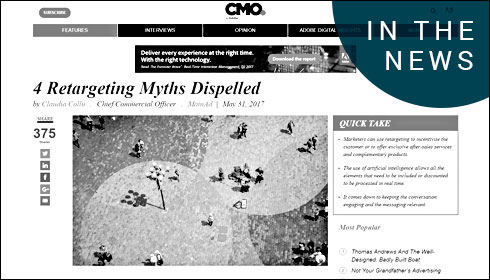
4 Retargeting Myths Dispelled
The concept of retargeting often conjures an image of brands directing repetitive ads at internet users until they either convert or block all contact with advertisers.
While this is far from accurate, the fact that, globally, 615 million devices used ad blocking software by the end of 2016 means the industry needs to act quickly to dispel these misconceptions and correctly utilise retargeting.
Brands are beginning to realise the more data that flows through their marketing funnel, the greater the opportunity to successfully optimise campaigns. When executed effectively, retargeting isn’t a blunt tool for scattergun marketing practices, but a precise instrument enabling meaningful, timely interactions with consumers.
With so much more than meets the eye, we must look at the importance of this tool and why marketers should re-evaluate their retargeting policies as part of a wider strategy.
Myth 1: Retargeting should only be conducted via a single partner.
Reality: Selecting multiple retargeting partners allows access to a wider range of resources and extends customer reach.
Many advertisers believe it is simpler to focus on one retargeting partner to effectively execute campaigns. A common claim is that multiple retargeters create internal competition, which may cause an increase in inventory cost. This is a huge misconception—it is very unlikely that one partner, or two, or even five partners can create a consistent effect in the marketplace. What’s most important here, and what advertisers usually miss, is that brands are in constant competition with each other, especially for the few precious users who are actual potential buyers. A greater number of retargeters can maximise reach and brand visibility in the lower part of the sales funnel, which is where brands want to be if they are in pursuit of conversions. Moreover, different partners will use different algorithms, thus providing a more varied source of data points against which to optimise ads.
Myth 2: Retargeting is intrusive and annoying.
Reality: It shouldn’t be—when done right!
The aim of retargeting is to engage with existing audiences—for example, a past customer that showed interest in a particular product or service. However, the very term “retarget” implies honing in on an unsuspecting online customer again and again, and marketers must appreciate users may associate retargeting with an invasion of their privacy rather than seeing it as a helpful prompt to take that vital last step along the path to purchase.
Once advertisers understand this, they can begin to build the customer relationship in a number of ways. They can address privacy concerns by allowing customers to opt in or out of retargeting, and ensure their messaging is as relevant as possible—for example, being integrated into real-time inventory logs to prevent the delivery of ads for out-of-stock products. Tactics such as frequency capping and A/B testing are vital to ensure retargeting is effective without becoming intrusive. Marketers can also use retargeting to incentivise the customer—perhaps, by presenting a voucher code—or to offer exclusive after-sales services and complementary products once a customer has converted, to re-engage them and continue to build brand loyalty.
Myth 3: Retargeting does not involve creative strategy.
Reality: The best retargeting strategies incorporate programmatic and creativity in equal measures.
One of the most common misconceptions about retargeted ads is that they are based purely on historical data and are, therefore, simple in design, lacking in original content and unlikely to attract the attention of—let alone fully immerse—the customer. In reality, tools such as Dynamic Creative Optimisation (DCO) can be implemented to ensure retargeted ads are on-brand and easily identifiable. Using customer data to inspire innovative retargeting creatives adds that all-important personal touch and can help a brand reach a customer at the right time, at the right intervals, with the right content.
Both the look and feel of a campaign, as well as messaging, should be developed creatively. All of the key identifying elements of the branding can be repurposed through dynamic creatives, from colours and font, to language and shapes. The message can vary depending on the position of the user in the sales funnel, seasonalities, and possibly even categories, to deliver bespoke campaigns that are tailored to the individual.
Myth 4: Retargeting does not drive incremental sales.
Reality: New methods of retargeting are proven to boost engagement and conversion.
With the sheer volume of data available to marketers during a campaign, extracting actionable insight for retargeting can seem a daunting task. Enter machine learning.
Where traditional automation involves the delivery of standard ad formats at scale, the use of artificial intelligence allows all the elements that need to be included or discounted to be processed in real time, creating truly adaptive campaigns. Machine learning can allow improved customer engagement and optimise cost savings by leveraging the power of big data. No user is equal to another, but even a single person may portray different characteristics depending on the time of day, location, or interaction with specific brands. Marketers can tap into this rich dataset and make the most of the vast amounts of big data available—and with the right technology in place, individual prospects can be reached instead of targeting cluster audiences. All of these elements, brought together and put in place correctly, can ensure not only the visibility that retargeting provides, but also an uplift in conversions.
For too long the advertising industry has battled against the consumer perception that brands are continually on the warpath, aiming to deliver as many ads as possible until a purchase is made. But with the right combination of tools, marketers can slowly but surely begin to dispel the negative connotations that surround retargeting and focus on building more sustainable relationships with their most important asset—the customer. In the end, it comes down to keeping the conversation engaging and the messaging relevant. If users are offered true added value, they will appreciate it.
First published on CMO.com. By Claudia Collu, CCO at MainAd. Read the original article here.

Claudia Collu, Chief Commercial Officer, MainAd